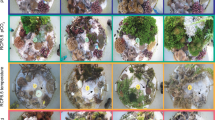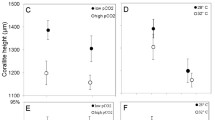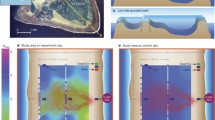Abstract
To predict coral responses to future environmental changes at the reef scale, the coral polyp model (Nakamura et al. in Coral Reefs 32:779–794, 2013), which reconstructs coral responses to ocean acidification, flow conditions and other factors, was incorporated into a reef-scale three-dimensional hydrodynamic-biogeochemical model. This coupled reef-scale model was compared to observations from the Shiraho fringing reef, Ishigaki Island, Japan, where the model accurately reconstructed spatiotemporal variation in reef hydrodynamic and geochemical parameters. The simulated coral calcification rate exhibited high spatial variation, with lower calcification rates in the nearshore and stagnant water areas due to isolation of the inner reef at low tide, and higher rates on the offshore side of the inner reef flat. When water is stagnant, bottom shear stress is low at night and thus oxygen diffusion rate from ambient water to the inside of the coral polyp limits respiration rate. Thus, calcification decreases because of the link between respiration and calcification. A scenario analysis was conducted using the reef-scale model with several pCO2 and sea-level conditions based on IPCC (Climate change 2013: the physical science basis. Contribution of working group I to the fifth assessment report of the intergovernmental panel on climate change, Cambridge University Press, Cambridge, 2013) scenarios. The simulation indicated that the coral calcification rate decreases with increasing pCO2. On the other hand, sea-level rise increases the calcification rate, particularly in the nearshore and the areas where water is stagnant at low tide under present conditions, as mass exchange, especially oxygen exchange at night, is enhanced between the corals and their ambient seawater due to the reduced stagnant period. When both pCO2 increase and sea-level rise occur concurrently, the calcification rate generally decreases due to the effects of ocean acidification. However, the calcification rate in some inner-reef areas will increase because the positive effects of sea-level rise offset the negative effects of ocean acidification, and total calcification rate will be positive only under the best-case scenario (RCP 2.6).

Modified from Nakamura et al. (2013)












Similar content being viewed by others
References
Allemand D, Ferrier-Pagès C, Furla P, Houlbrèque F, Puverel S, Reynaud S, Tambutté É, Tambutté S, Zoccola D (2004) Biomineralisation in reef-building corals: from molecular mechanisms to environmental control. Comptes Rendus Palevol 3:453–467
Blanco AC, Watanabe A, Nadaoka K, Motooka S, Herrera EC, Yamamoto T (2011) Estimation of nearshore groundwater discharge and its potential effects on a fringing coral reef. Mar Pollut Bull 62:770–785
Booij N, Ris RC, Holthuijsen LH (1999) A third-generation wave model for coastal regions: 1. Model description and validation. J Geophys Res 104:7649–7666
Britton CM, Dodd JD (1976) Relationships of photosynthetically active radiation and shortwave irradiance. Agric Meteorol 17:1–7
Chapman DC (1985) Numerical treatment of cross-shelf open boundaries in a barotropic coastal ocean model. J Phys Oceanogr 15:1060–1075
Comeau S, Edmunds PJ, Lantz CA, Carpenter RC (2014) Water flow modulates the response of coral reef communities to ocean acidification. Sci Rep 4:6681
Fabricius KE (2005) Effects of terrestrial runoff on the ecology of corals and coral reefs: review and synthesis. Mar Pollut Bull 50:125–146
Fabricius KE, Langdon C, Uthicke S, Humphrey C, Noonan S, De’ath G, Okazaki R, Muehllehner N, Glas MS, Lough JM (2011) Losers and winners in coral reefs acclimatized to elevated carbon dioxide concentrations. Nat Clim Chang 1:165–169
Falter JL, Lowe RJ, Zhang Z (2016) Towards a universal mass-momentum transfer relationship for predicting nutrient uptake and metabolite exchange in benthic reef communities. Geophys Res Lett 43:9764–9772
Falter JL, Lowe RJ, Zhang Z, McCulloch M (2013) Physical and biological controls on the carbonate chemistry of coral reef waters: effects of metabolism, wave forcing, sea level, and geomorphology. PLoS One 8:e53303
Flather RA (1976) A tidal model of the northwest European continental shelf. Memoires de la Societe Royale de Sciences de Liege 6:141–164
García HE, Gordon LI (1992) Oxygen solubility in seawater: better fitting equations. Limnol Oceanogr 37:1307–1312
Haidvogel DB, Arango H, Budgell WP, Cornuelle BD, Curchitser E, Di Lorenzo E, Fennel K, Geyer WR, Hermann AJ, Lanerolle L, Levin J, McWilliams JC, Miller AJ, Moore AM, Powell TM, Shchepetkin AF, Sherwood CR, Signell RP, Warner JC, Wilkin J (2008) Ocean forecasting in terrain-following coordinates: formulation and skill assessment of the Regional Ocean Modeling System. J Comput Phys 227:3595–3624
Hoegh-Guldberg O (1999) Climate change, coral bleaching and the future of the world’s coral reefs. Mar Freshw Res 50:839–866
Hoegh-Guldberg O, Mumby PJ, Hooten aJ, Steneck RS, Greenfield P, Gomez E, Harvell CD, Sale PF, Edwards aJ, Caldeira K, Knowlton N, Eakin CM, Iglesias-Prieto R, Muthiga N, Bradbury RH, Dubi A, Hatziolos ME (2007) Coral reefs under rapid climate change and ocean acidification. Science 318:1737–1742
Hohn S, Merico A (2012) Modelling coral polyp calcification in relation to ocean acidification. Biogeosciences 9:4441–4454
Hohn S, Merico A (2015) Quantifying the relative importance of transcellular and paracellular ion transports to coral polyp calcification. Front Earth Sci 2:37
Hongo C, Kayanne H (2009) Holocene coral reef development under windward and leeward locations at Ishigaki Island, Ryukyu Islands, Japan. Sediment Geol 214:62–73
Inoue S, Kayanne H, Yamamoto S, Kurihara H (2013) Spatial community shift from hard to soft corals in acidified water. Nat Clim Chang 3:683
IPCC (2013) Climate change 2013: the physical science basis. Contribution of working group I to the fifth assessment report of the intergovernmental panel on climate change. Cambridge University Press, Cambridge
Kan H, Kawana T (2006) “Catch-up” of a high-latitude barrier reef by back-reef growth during post-glacial sea-level rise, Southern Ryukyus, Japan. Proc 10th Int Coral Reef Symp 1:494–503
Kawahata H, Yukino I, Suzuki A (2000) Terrestrial influences on the Shiraho fringing reef, Ishigaki Island, Japan: high carbon input relative to phosphate. Coral Reefs 19:172–178
Kayanne H, Hata H, Kudo S, Yamano H, Watanabe A, Ikeda Y, Nozaki K, Kato K, Negishi A, Saito H (2005) Seasonal and bleaching-induced changes in coral reef metabolism and CO2 flux. Global Biogeochem Cycles 19:3015
Kayanne H, Kudo S, Hata H, Yamano H, Nozaki K, Kato K, Negishi A, Saito H, Akimoto F, Kimoto H (2008) Integrated monitoring system for coral reef water pCO2, carbonate system and physical parameters. Proc 9th Int Coral Reef Symp 2:1079–1084
Lowe RJ, Falter JL, Monismith SG, Atkinson MJ (2009) Wave-driven circulation of a coastal resef–lagoon ystem. J Phys Oceanogr 39:873–893
McConnaughey TA, Falk RH (1991) Calcium-proton exchange during algal calcification. Biol Bull 180:185–195
McConnaughey TA, Whelan JF (1997) Calcification generates protons for nutrient and bicarbonate uptake. Earth-Science Rev 42:95–117
Monismith SG (2007) Hydrodynamics of coral reefs. Annu Rev Fluid Mech 39:37–55
Nakamura T, Nakamori T (2007) A geochemical model for coral reef formation. Coral Reefs 26:741–755
Nakamura T, Nakamori T (2009) Estimation of photosynthesis and calcification rates at a fringing reef by accounting for diurnal variations and the zonation of coral reef communities on reef flat and slope: a case study for the Shiraho reef, Ishigaki Island, southwest Japan. Coral Reefs 28:229–250
Nakamura T, Nakamori T (2011) A simulation model for coral reef formation: reef topographies and growth patterns responding to relative sea-level histories. In: Wright LL (ed) Sea level rise, coastal engineering, shorelines and tides. Nova Science Publishers, Hauppauge, pp 251–261
Nakamura T, Nadaoka K, Watanabe A (2013) A coral polyp model of photosynthesis, respiration and calcification incorporating a transcellular ion transport mechanism. Coral Reefs 32:779–794
Neumann AC, Macintyre I (1985) Reef response to sea level rise: keep-up, catch-up or give up. Proc 5th Int Coral Reef Symp 3:105–110
Ow YX, Collier CJ, Uthicke S (2015) Responses of three tropical seagrass species to CO2 enrichment. Mar Biol 162:1005–1017
Paringit EC, Nadaoka K (2012) Simultaneous estimation of benthic fractional cover and shallow water bathymetry in coral reef areas from high-resolution satellite images. Int J Remote Sens 33:3026–3047
Shchepetkin AF, McWilliams JC (2005) The regional oceanic modeling system (ROMS): a split-explicit, free-surface, topography-following-coordinate oceanic model. Ocean Model 9:347–404
Styles R, Glenn S (2000) Modeling stratified wave and current bottom boundary layers on the continental shelf. J Geophys Res 105:24119–24139
Suzuki A, Nakamori T, Kayanne H (1995) The mechanism of production enhancement in coral reef carbonate systems: model and empirical results. Sediment Geol 99:259–280
Taebi S, Lowe RJ, Pattiaratchi CB, Ivey GN, Symonds G (2012) A numerical study of the dynamics of the wave-driven circulation within a fringing reef system. Ocean Dyn 62:585–602
Tamura H, Nadaoka K, Paringit EC (2007) Hydrodynamic characteristics of a fringing coral reef on the east coast of Ishigaki Island, southwest Japan. Coral Reefs 26:17–34
Umezawa Y, Miyajima T, Yamamuro M, Kayanne H, Koike I (2002) Fine-scale mapping of land-derived nitrogen in coral reefs by δ15 N in macroalgae. Limnol Oceanogr 47:1405–1416
Wanninkhof R (1992) Relationship between wind speed and gas exchange. J Geophys Res 97:7373–7382
Warner JC, Sherwood CR, Arango HG, Signell RP (2005) Performance of four turbulence closure models implemented using a generic length scale method. Ocean Model 8:81–113
Warner JC, Defne Z, Haas K, Arango HG (2013) A wetting and drying scheme for ROMS. Comput Geosci 58:54–61
Watanabe A, Yamamoto T, Nadaoka K, Maeda Y, Miyajima T, Tanaka Y, Blanco AC (2013) Spatiotemporal variations in CO2 flux in a fringing reef simulated using a novel carbonate system dynamics model. Coral Reefs 32:239–254
Weiss RF (1974) Carbon dioxide in water and seawater: the solubility of a non-ideal gas. Mar Chem 2:203–215
Willmott CJ (1981) On the validation of models. Phys Geogr 2:184–194
Yamamoto S, Kayanne H, Tokoro T, Kuwae T, Watanabe A (2015) Total alkalinity flux in coral reefs estimated from eddy covariance and sediment pore-water profiles. Limnol Oceanogr 60:229–241
Yamamoto S, Kayanne H, Terai M, Watanabe A, Kato K, Negishi A, Nozaki K (2012) Threshold of carbonate saturation state determined by CO2 control experiment. Biogeosciences 9:1441–1450
Zhang Z, Lowe R, Falter J, Ivey G (2011) A numerical model of wave- and current-driven nutrient uptake by coral reef communities. Ecol Modell 222:1456–1470
Acknowledgements
We thank Prof. H. Kayanne, Dr. H. Kurihara, Prof. Y. Suzuki, Dr. S. Yamamoto, and Mr. L. P. C. Bernardo for their helpful comments and support. We thank anonymous reviewers for their constructive comments on our manuscript. This work was supported by Grants-in-Aid for Scientific Research on Innovative Areas (Nos. 20121007, 21121501) from the Ministry of Education, Culture, Sports, Science and Technology (MEXT) in Japan, Grants-in-Aid for Scientific Research (A) (Nos. 24246086, 25257305, 15H02268) from The Japan Society for the Promotion of Science (JSPS), a Grant-in-Aid for Young Scientists (B) (No. 22740336) from JSPS, a Grant-in-Aid for Exploratory Research (No. 26610167) from JSPS, and the JSPS Japan-Philippines Research Cooperative Program.
Author information
Authors and Affiliations
Corresponding author
Additional information
Communicated by Biology Editor Dr. Mark R. Patterson
Electronic supplementary material
Below is the link to the electronic supplementary material.
Animation S1
Time-dependent changes in significant wave height and wave direction (arrow) (GIF 6872 kb)
Animation S2
Time-dependent changes in sea surface velocity (GIF 8528 kb)
Animation S3
Time-dependent changes in sea surface temperature (GIF 5870 kb)
Animation S4
Time-dependent changes in sea surface DIC (GIF 4851 kb)
Animation S5
Time-dependent changes in sea surface TA (GIF 4652 kb)
Animation S6
Time-dependent changes in sea surface DO (GIF 4985 kb)
Animation S7
Time-dependent changes in sea surface pH (total scale) (GIF 4484 kb)
Animation S8
Time-dependent changes in pCO2 in surface seawater (GIF 5073 kb)
Animation S9
Time-dependent changes in sea surface aragonite saturation state (GIF 5256 kb)
Animation S10
Time-dependent changes in polyp gross photosynthetic rate of inner reef corals under present conditions (GIF 1302 kb)
Animation S11
Time-dependent changes in polyp respiration rate of inner reef corals under present conditions (GIF 2469 kb)
Animation S12
Time-dependent changes in polyp net photosynthetic rate of inner reef corals under present conditions (GIF 2104 kb)
Animation S13
Time-dependent changes in polyp calcification rate of inner reef corals under present conditions (GIF 2588 kb)
Animation S14
Time-dependent changes in polyp stored organic carbon of inner reef corals under present conditions (GIF 2373 kb)
Rights and permissions
About this article
Cite this article
Nakamura, T., Nadaoka, K., Watanabe, A. et al. Reef-scale modeling of coral calcification responses to ocean acidification and sea-level rise. Coral Reefs 37, 37–53 (2018). https://doi.org/10.1007/s00338-017-1632-3
Received:
Accepted:
Published:
Issue Date:
DOI: https://doi.org/10.1007/s00338-017-1632-3




